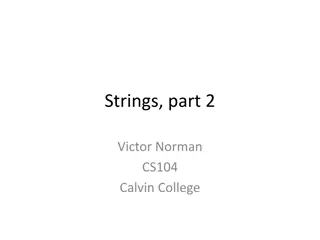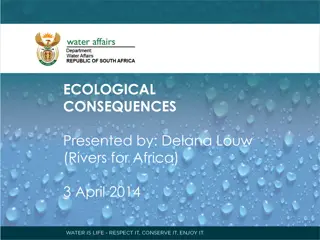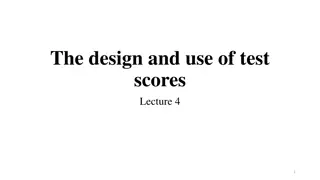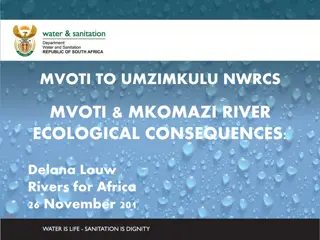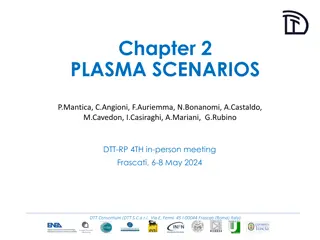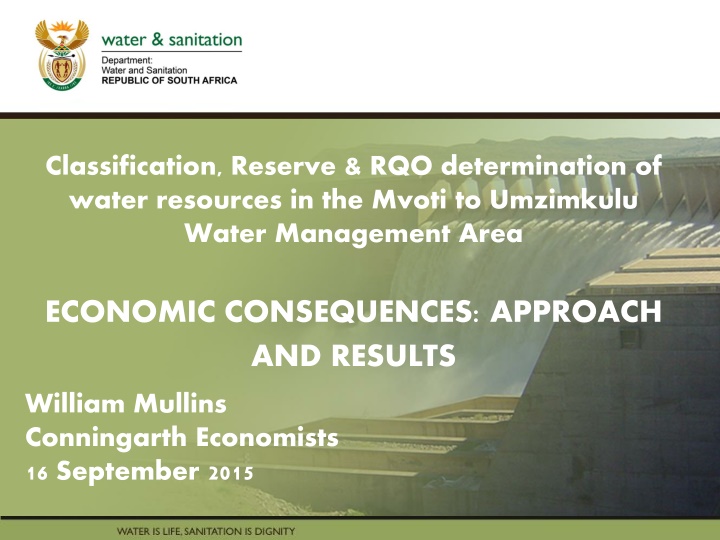
Economic Consequences of Water Resource Management in Mvoti to Umzimkulu Area
Explore the economic impact of water decisions in the Mvoti to Umzimkulu area through GDP and employment parameters. Discover the methodology based on Cost-Benefit Analysis principles to project GDP growth and additional labor. Results of uMngeni Catchment scenarios also discussed.
Download Presentation

Please find below an Image/Link to download the presentation.
The content on the website is provided AS IS for your information and personal use only. It may not be sold, licensed, or shared on other websites without obtaining consent from the author. If you encounter any issues during the download, it is possible that the publisher has removed the file from their server.
You are allowed to download the files provided on this website for personal or commercial use, subject to the condition that they are used lawfully. All files are the property of their respective owners.
The content on the website is provided AS IS for your information and personal use only. It may not be sold, licensed, or shared on other websites without obtaining consent from the author.
E N D
Presentation Transcript
Classification, Reserve & RQO determination of PRESENTATION TITLE water resources in the Mvoti to Umzimkulu Water Management Area Presented by: Name Surname Directorate ECONOMIC CONSEQUENCES: APPROACH AND RESULTS Date William Mullins Conningarth Economists 16 September 2015
Structure of Presentation Where do economics fit in to the decision making? What approach has been followed? Specific approach in this section Results of the different options
Any decision on water has an impact on the economic and socio-economic situation of the immediate surroundings. It involves: The current situation; and The future situation
Why GDP and Employment as parameters? GDP is the universal accepted parameter to measure economic growth (impact). Gross domestic product (GDP) is defined as "an aggregate measure of production equal to the sum of the gross values added of all resident, institutional units engaged in production (plus any taxes, and minus any subsidies, on products not included in the value of their outputs) GDP estimates are commonly used to measure the economic performance of a whole country or region, but can also measure the relative contribution of an industry sector Employment is an indicator of the socio-economic impact of any scenario
Methodology based on CBA principles Methodology for baseline based on CBA principles Status quo Volume of water Status quo Value of water in GDP Growth on status quo Apply value of water on growth volume Status quo Employment Discount according to CBA principles Apply employment on growth volume Projected additional employment Projected GDP growth
Results of uMngeni Catchment Results of the operational scenarios in the uMngeni Catchment: Additional allocation (million m3/a) Projected GDP growth (R million) Projected additional labour URV URV (R/m3) Sc (Number/mm 3) UM41 142.2 R 13 927 208 611 R15.95 239 UM51 205 R 11 942 232 725 R10.73 209
Results of Lovu Catchment Results of the operational scenarios in the Lovu Catchment Reduction in forestry water volume (mm3/a) Projected GDP growth (R million) Projected additional labour Sc -4 156 2.65 R -388 LO3 5.30 R -775 -8 312 LO4
Methodology followed to estimate the socio-economic impact Waste water management options are an building block in the final classification process. Certain decisions are already in place when these are investigated in terms of the best overall scenarios. These scenarios are investigated as ad on to the already taken decisions.
Waste Water Options Implementation The Capital and Operational Costs of all of the Waste Water Options (on next slide) were implemented in the Cost Benefit Analysis on the applicable timescale and discounted to a comparable value, the Net Present Value, for the two metrics GDP and employment Scenarios breakdown: A Scenarios: Ecological Protection is priority B Scenarios: Highest discharge into estuaries C & D Scenarios: Capital expenditure time delay E & F Scenarios: Indirect reuse & Direct reuse Note the high costs of the reuse options
Scenario Description Ecological Protection Priority Fall Back option for Scenario Ai As in Ai but WW plants to capacity Highest discharge into estuaries Scenario Bi with alternative 5 year plan CAPEX (R Million) 7 069.80 OPEX (R Million) 551.83 Scenario Ai Scenario Aii 7 476.83 453.00 Scenario Aiii 6 921.73 582.35 Scenario Bi 6 873.80 810.69 Scenario Bii 7 336.54 753.38 Scenario C 6 727.96 626.10 Scenario D 10 year plan 6 409.62 688.29 Scenario E Indirect reuse 8 372.07 710.73 Scenario F Direct reuse 14 063.28 1 319.28 Scenario Biii Highest discharge into estuaries Ecological Protection Priority Alternative of Scenario A 5 400.41 191.46 Scenario Aiv 7 338.59 602.68 Scenario Av 7 178.33 454.60 Scenario Ci 5 year plan 6 134.07 322.83 Scenario Di 10 year plan 5 667.25 338.52
Methodology based on CBA principles Waste Water Options integration in Cost Benefit Analysis: Baseline NPV Various CAPEX and OPEX of option combined on applicable timescale Waste Water Option Scenarios Costs Capex and Opex: Macro- economic impact derived from Social Accounting Matrix Capex and Opex: Impact on NPV Positive Capex and Opex: Opportunity cost of diverted funds from alternative projects Cost of investment: Impact on NPV negative Waste Water Options NPV
Approach to Analyse Scenarios E and F Show Exchange at Smithfield Dam Show capital used Benefit Calculation Net Present Value = PV benefits PV costs
Approach to Analyse Scenarios E and F Smithfield Total cost Reuse Hypothetical cost benefit from reuse 2040
Another look at Scenarios E and F Re-use options Discounted Cost Item Scenario E Rand Million Scenario F Rand Million Capital Costs - Waste Water R 12 088.63 R 13 441.63 Capital Costs Smithfield & Ngwadini R 13 526.86 R 5 556.30 Opex - Waste Water 39 years R 41 122.22 R 53 283.63 Opex Smithfield 39 Years R 1 553.65 R 1 553.65 Total R 68 291.36 R 73 835.21 Ranking GDP 11 1 Ranking Employment 10 4 2 2 Ranking Capital Costs 1 Ranking Operational Costs 1
Results Net Present Value is an inverse function of the capital and operational costs of the Waste Water Options The Scenarios were ranked by highest to lowest Net Present Value Ranking is based on the highest net benefit to society in terms of GDP and employment stimulation
Results CC IUA GDP Scenario Biii (Highest Discharge) yields the highest NPV because of its low cost Scenarios C, D, Ci and Di (5 year & 10 year plans) has higher NPVs than the remaining options since discounting a delayed cost yields a higher value The remaining scenarios with all their respective capital and operational costs taken into consideration with the related NPVs Scenario F (Indirect & Direct reuse) yields the lowest NPV because of its high cost. Despite the direct reuse benefit, this option still ranks the lowest since the cost exceeds the benefit in the discounted Cost Benefit Model
Results CC IUA Employment Scenario Biii (Highest Discharge) yields the highest NPV because of its low cost Scenarios C, D, Ci and Di (5 year & 10 year plans) has higher NPVs than the remaining options since discounting a delayed cost yields a higher value The remaining scenarios with all their respective capital and operational costs taken into consideration with the related NPVs Scenario F (Indirect & Direct reuse) yields the lowest NPV because of its high cost. Despite the direct reuse benefit, this option still ranks the lowest since the cost exceeds the benefit in the discounted Cost Benefit Model
Results SC IUA GDP Scenario Aii, Aiii, Aiv (WW at capacity) yields the highest NPV because of its low cost Scenarios Bi, Bii, Biii (Highest discharge into estuaries) yields the second highest set of NPVs Scenario D, Di (10 year plan) yields the third highest NPV Scenario C, Ci (5 year plan) yields the fourth highest NPV Scenario Ai, Av (Ecological protection is priority) yields the fifth highest NPV Scenario E,F (Indirect & Direct reuse) yields the lowest NPV because of its high cost. Despite the direct reuse benefit, these options still ranks the lowest since the cost exceeds the benefit in the discounted Cost Benefit Model
Results SC IUA Employment Scenario Aii, Aiii, Aiv (WW at capacity) yields the highest NPV because of its low cost Scenarios Bi, Bii, Biii (Highest discharge into estuaries) yields the second highest set of NPVs Scenario D, Di (10 year plan) yields the third highest NPV Scenario C, Ci (5 year plan) yields the fourth highest NPV Scenario Ai, Av (Ecological protection is priority) yields the fifth highest NPV Scenario E,F (Indirect & Direct reuse) yields the lowest NPV because of its high cost. Despite the direct reuse benefit, these options still ranks the lowest since the cost exceeds the benefit in the discounted Cost Benefit Model
Results NC IUA GDP Scenario D, Di (10 year plan) yields the highest NPV because of its low cost Scenarios Aii, Aiii, Aiv (WW plants to capacity) yields the second highest set of NPVs Scenario C, Ci (5 year plan) yields the third highest NPV Scenario Bi, Bii, Biii (Highest discharge into estuaries) yields the fourth highest NPV Scenario Ai, Av (Ecological protection is priority) yields the fifth highest NPV Scenario E,F (Indirect & Direct reuse) yields the lowest NPV because of its high cost. Despite the direct reuse benefit, these options still ranks the lowest since the cost exceeds the benefit in the discounted Cost Benefit Model
Results NC IUA Employment Scenario D, Di (10 year plan) yields the highest NPV because of its low cost Scenarios Aii, Aiii, Aiv (WW plants to capacity) yields the second highest set of NPVs Scenario C, Ci (5 year plan) yields the third highest NPV Scenario Bi, Bii, Biii (Highest discharge into estuaries) yields the fourth highest NPV Scenario Ai, Av (Ecological protection is priority) yields the fifth highest NPV Scenario E,F (Indirect & Direct reuse) yields the lowest NPV because of its high cost. Despite the direct reuse benefit, these options still ranks the lowest since the cost exceeds the benefit in the discounted Cost Benefit Model








